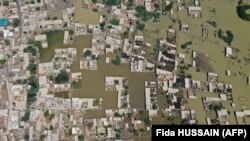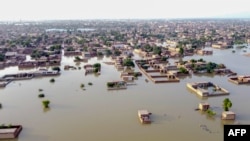The U.S. military said it was preparing to join international relief efforts in flood-ravaged Pakistan as the death toll from the disaster surged past 1,200 and the country braced for yet more flooding.
The U.S. Defense Department (DOD) on September 2 said its Central Command “is sending an assessment team to Islamabad to determine what potential support DOD can provide...as part of the United States' assistance to the flooding crisis in Pakistan."
Spokesman Colonel Joe Buccino said the decision followed a telephone call on September 1 between Central Command chief General Erik Kurilla and Pakistan's Chief of Army Staff, General Qamar Javed Bajwa.
The Pentagon has long-standing ties with the Pakistani military, but relations between the nations have often turned rocky over a variety of issues, including U.S. claims of Islamabad’s harboring of militants operating in Afghanistan.
The U.S. comments come as planes carrying humanitarian aid arrived in the South Asian nation, with the ninth flight from the United Arab Emirates (U.A.E.) and the first from Uzbekistan the latest to land in Islamabad overnight, according to Pakistan’s Foreign Ministry.
Two more planes from the U.A.E and Qatar were expected to arrive later in the day, while a Turkish train carrying relief goods for flood victims was on its way to Pakistan, officials in Ankara said.
Earlier this week, the United Nations appealed for $160 million to help with what it has called an "unprecedented climate catastrophe.”
In a statement on September 2, the UN refugee agency said although the response to the appeal was “very encouraging," more help is needed.
UNHCR spokesman Matthew Saltmarsh said its teams were distributing tents, blankets, plastic sheets, buckets, and other household items for flood victims.
Secretary-General Antonio Guterres is due to visit Pakistan on September 9 to tour flood-hit areas and meet with officials.
Rescue workers -- supported by military helicopters and boats -- were scrambling to evacuate millions of people from remote villages in southern Pakistan on September 2.
Almost 20,000 cubic meters of water per second is now flowing downstream from the country’s north and will shortly reach major cities in Sindh, the Disaster Management Agency said. Sindh has been the worst-hit province in a series of floods that have occurred since mid-June.
"We are trying to reach people who are still in the middle of water without food and shelter," Rustam Jamali, a Sindh rescue worker told the dpa news agency.
Health experts have warned about possible outbreaks of infectious diseases and other illnesses in flood-affected areas. The World Health Organization (WHO) said the floods have damaged at least 888 medical facilities, hampering the country’s response to health crises in the aftermath of the disaster.
The government says more than 33 million people -- or 15 percent of the 220 million population -- have been affected by the floods. Some estimates say one-third of the country is currently under water.










